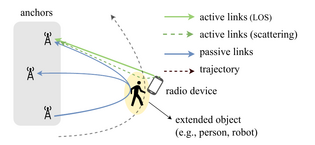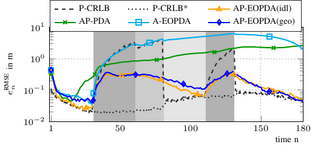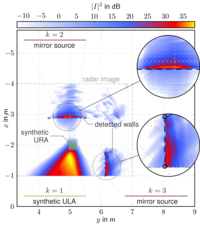Posterior Cramér-Rao Bounds on Localization and Mapping Errors in Distributed MIMO SLAM
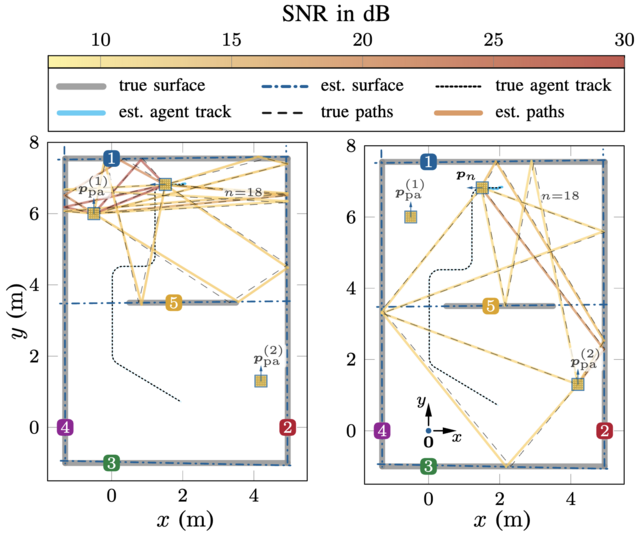
04.11.2025
Last week, we presented our paper "Posterior Cramér–Rao Bounds on Localization and Mapping Errors in Distributed MIMO SLAM" [1] at the #Asilomar Conference. The paper introduces the mapping error bound (MEB)—a lower bound that quantifies how accurately specular surfaces can be estimated in radio-frequency (RF) simultaneous localization and mapping (SLAM). The bound covers single- and double-bounce multipath components and distributed anchors, and we show a state-of-the-art RF-SLAM algorithm [2] asymptotically approaches this bound.
In positioning, map information improves user localization. In communications, map information provides a geometric representation of the multipath channel, enabling the prediction and tracking of channel state information. The bounds presented in our paper enable benchmarking of the performance of SLAM algorithms that jointly estimate the user position and the environment map.
Contact: LinkedIn
Fast and Principled Learning for Sparse Signal Recovery
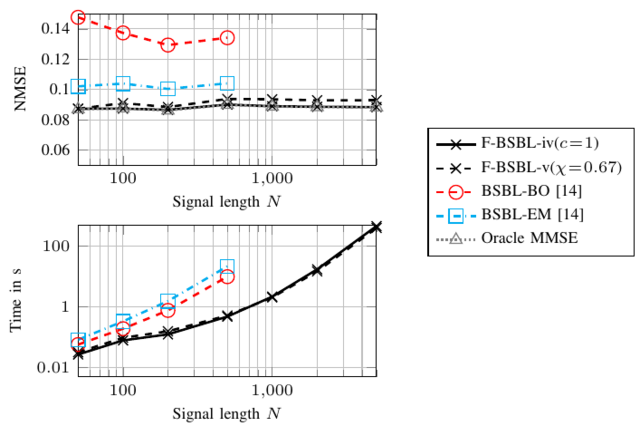
13.10.2025
From wireless communication networks to medical imaging and radar systems, many modern technologies depend on the ability to detect just a few meaningful signals buried in massive amounts of data. This task — known as sparse signal recovery — is essential for making sense of complex measurements, but existing algorithms can be painfully slow, especially when the signals come in naturally grouped patterns, known as block sparsity.
In our recent work [1], we developed a new algorithm called Fast Variational Block-Sparse Bayesian Learning (F-BSBL) that makes this process dramatically faster and more efficient. By rethinking how uncertainty and structure are handled in sparse models, we achieved up to a hundredfold speedup over existing approaches — without sacrificing accuracy. Our method also unifies several previously separate learning strategies into a single, elegant mathematical framework. Tested on challenging problems such as direction-of-arrival estimation, F-BSBL delivers both speed and precision, paving the way for real-time signal analysis in next-generation communication, sensing, and data-driven technologies.
- J. Möderl, E. Leitinger, B. H. Fleury, F. Pernkopf and K. Witrisal, "Fast Variational Block-Sparse Bayesian Learning," in IEEE Transactions on Signal Processing, doi: 10.1109/TSP.2025.3611234
Contact:
Jakob Möderl
Adaptive Multipath-Based SLAM for Distributed MIMO Systems
30.06.2025
Localizing users and mapping the environment using radio signals is a key task in emerging applications such as reliable, low-latency communications, location-aware security, and safety-critical navigation. Recently introduced multipath-based simultaneous localization and mapping (MP-SLAM) can jointly localize a mobile agent (i.e., the user) and the reflective surfaces (such as walls) in radio frequency (RF) environments with convex geometries. Most existing MP-SLAM methods assume that map features and their corresponding RF propagation paths are statistically independent. These existing methods neglect inherent dependencies that arise when a single reflective surface contributes to different propagation paths or when an agent communicates with more than one base station (BS).
In our paper [1], we propose a Bayesian MP-SLAM method for distributed MIMO systems that addresses this limitation. In particular, we make use of amplitude statistics to establish adaptive time-varying detection probabilities. Based on the resulting “soft” ray-tracing strategy, our method can fuse information across propagation paths in RF environments with nonconvex geometries. A Bayesian estimation method for the joint estimation of map features and agent position is established. Our method is validated using synthetic RF measurements in a challenging scenario with nonconvex geometry and capable of early detection of new surfaces solely through double-bounce paths. Our algorithm provides accurate localization and mapping estimates and attains the posterior Cramér-Rao lower bound (PCRLB) [2].
[1] Xuhong Li, Benjamin Deutschmann, Erik Leitinger, and Florian Meyer, “Adaptive Multipath-Based SLAM for Distributed MIMO Systems,” unpublished, submitted for publication to IEEE Trans. Wireless Commun. [Online]. Available: https://arxiv.org/abs/2506.21798
[2] Benjamin Deutschmann, Xuhong Li, Florian Meyer, and Erik Leitinger, “Posterior Cramér-Rao Bounds on Localization and Mapping Errors in Distributed MIMO SLAM,” unpublished, submitted for publication to Asilomar-25, [Online]. Available: https://arxiv.org/abs/2506.19957
Contact: Erik Leitinger
LinkedIn
Multi-Sensor Fusion of Active and Passive Measurements for Extended Object Tracking
27.05.2025
In many real-world scenarios - like when a person carries a radio device - direct line-of-sight (LoS) signals from surrounding anchors (e.g., base stations or sensors) can get blocked by the person's own body. This makes accurate positioning difficult, especially in challenging indoor or cluttered environments.
Our recent work tackles this problem by treating the person not just as an obstacle, but as a key part of the solution. We model the person as an extended object (EO) that can scatter and attenuate signals. Instead of relying only on LoS measurements, we combine:
- Active measurements between the device and fixed anchors
- Passive measurements between pairs of anchors that reflect off the person
We developed a Bayesian estimation framework and an extended object data association algorithm that can make sense of these complex, indirect signals.
The result shows that the proposed joint estimation algorithm (AP-EOPDA) is much more reliable and accurate in positioning - even when the LoS is completely blocked [1].
This approach outperforms traditional methods that assume the point-target or rely solely on LoS signals. It opens the door to more robust and energy-efficient localization, especially in environments where unavailable LoS is common.
Feel free to reach out if you're working on related problems or want to know more about the technical details!
[1] Hong Zhu and Alexander Venus and Erik Leitinger and Klaus Witrisal, "Multi-Sensor Fusion of Active and Passive Measurements for Extended Object Tracking", in 33rd European Signal Processing Conference (EUSIPCO 2025), DOI:10.48550/arXiv.2504.18301.
Contact:
hong.zhu@tugraz.at
https://www.linkedin.com/in/hong-zhu-74173427a/
Delay-Doppler-based Direct Positioning in D-MIMO
In this work we exploit the delay-Doppler characteristics of the channel state infromation to track a moving device. Together with a group of colleagues, we worked with realistic measurement data collected in an industrial scenario consisting of a trajectory going through various types of channel characteristics, ranging from clear line-of-sight (LOS), over obstructed LOS to non line-of-sight (NLOS) for the various anchors.
Watch the video below and listen to the explanation of Benjamin Deutschmann, describing how the developed algorithm deals with this difficult scenario. Head over to IEEEXplore to read the final paper or check out the pre-print on arXiv.
Bistatic MIMO radar sensing
We recently published results about MIMO radar sensing. The results show how passive sensing of reflective surfaces can be achieved with large arrays.
More details can be found at this link in our paper.
